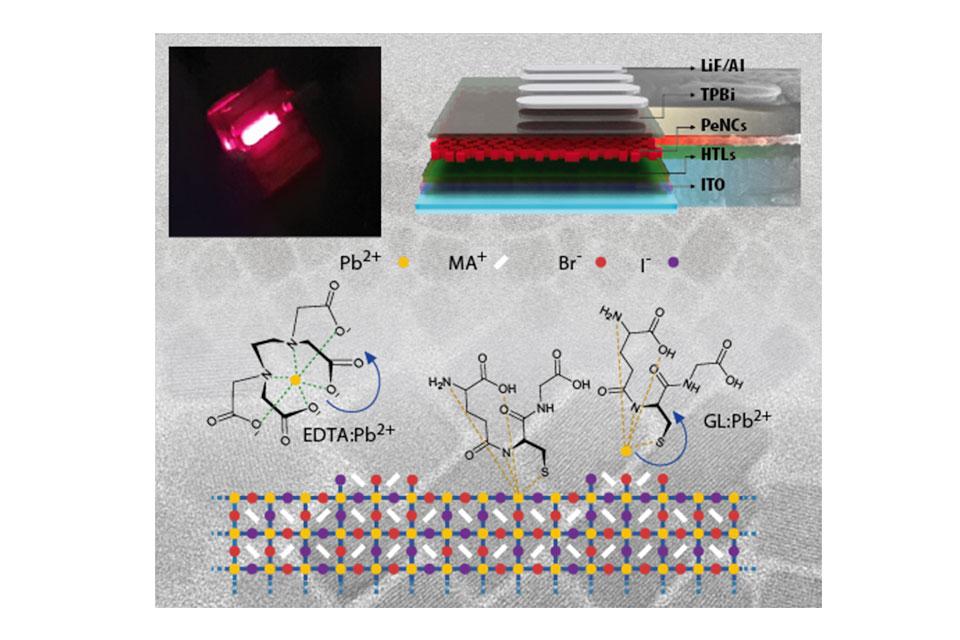The latest findings of a team of researchers at Oxford's Department of Physics add further weight to perovskites earning their status as wonder-materials in the world of semiconductors. Their results are published in Nature.
The latest study demonstrates that lead halide perovskites are promising semiconductors for light-emitting applications owing to their bright, tuneable and high colour purity luminescence. The group's findings mark the latest step in exploiting the power of perovskites – not only for light emission but also a potentially broader impact for other optoelectronic applications such as photovoltaics.
Promising semiconductors
Yasser Hassan is the lead author of the study: 'Perovskites are incredibly exciting as their role as semiconductors could transform the way we harvest the sunlight, lighting the world, sensing radiations, and clean nuclear waste. Studies like ours are essential in understanding how they work as a material and so how they could be used in everyday life. Our latest findings are a big contribution to the relatively young and blossoming community engaged in understanding the mysterious instability of perovskite materials.'
Today, one of the biggest challenges in materials science and energy conversion is discovering optimal materials for a long list of urgent technologies such as efficient optoelectronics, long-life batteries, sensors, effective catalysts, and efficient superconductors; and quantum computing. A decade ago, Professor Henry Snaith published his first lab report [1] on perovskite solar cells, having uncovered the huge promise of the wonder-materials. Subsequent studies have revealed more insights into their make-up and behaviour as well as highlighted challenges such as chemical instability and parasitic non-radiative losses.
Learning from nature
In this paper, the group searched for the chemistry mechanistic clues that reveal the degradation pathways and instability mechanism, and they managed to overcome them. They first looked at perovskite elemental composition and found the presence of any unbounded lead atoms on the surface of perovskite can cause a degradation known as the halide-segregation. Learning from nature – how biological systems like the human liver detoxify toxic lead – the group found lead-complexing multidentate ligands such as ethylenediaminetetraacetic acid (EDTA), and L-glutathione reduced can 'clean' the perovskite nanocrystal surface through the removal of lead atoms.
The nature of binding between these ligands and the nanocrystal surface suppresses the defect formation and inhibits halide-segregation. Typically, ligands graft into perovskite surfaces and diminish their surface energies toward undesired pathways, subsequently augmenting their photo- and chemical stability. This treatment step leads to bandgap-stable red electroluminescence from mixed halide perovskite NC-LEDs, with a peak EQE at 620 nm surpassing 20%. The group found that stripping the NC surface of defects is part of the active role of the ligands.
Critical findings
Hassan et al's work exemplifies how the functionality of metal halide perovskites is extremely sensitive to the nature of the (nano)crystalline surface and presents a route for controlling surface defect formation and migration. This is critical for achieving band gap stability for light emission and may also have a broader impact for other optoelectronic applications, such as photovoltaics, where bandgap stability is required. Beyond light emission, the group's work is likely to be broadly applicable to stabilising the bandgap of mixed-ion metal halide perovskites for a range of applications, including multi-junction photovoltaics, and will enable perovskites to deliver upon the promise of being remarkably versatile and tuneable semiconductors.
1. MM Lee, J Teuscher, T Miyasaka, TN Murakami, and HJ Snaith, Efficient hybrid solar cells based on meso-superstructured organometal halide perovskites., Science 338 (6107), 643-647
Ligand engineered bandgap stability in mixed-halide perovskite LEDs, Y Hassan et al, Nature 591, 2021

